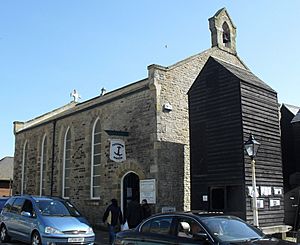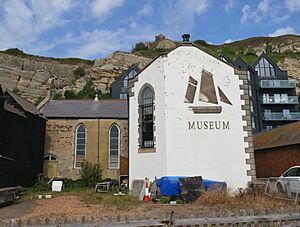Hastings Fishermen's Museum facts for kids
Quick facts for kids Hastings Fishermen's Museum(Formerly St Nicholas' Church) |
|
|---|---|

The building from the northwest
|
|
| Location | Rock-a-Nore Road, Rock-a-Nore, Hastings, East Sussex TN34 3DW |
| Founded | 1854 |
| Built | 1854 |
| Built for | Church of England (as St Nicholas' Church) |
| Restored | 1956 |
| Restored by | Old Hastings Preservation Society |
| Architect | William J. Gant |
| Architectural style(s) | Gothic Revival |
| Visitors | 140,000 (in 2008) |
|
Listed Building – Grade II
|
|
| Official name: Fishermen's Museum | |
| Designated | 14 September 1976 |
| Reference no. | 1043428 |
| Lua error in Module:Location_map at line 420: attempt to index field 'wikibase' (a nil value). | |
The Hastings Fishermen's Museum is a cool place to visit in Hastings, a town by the sea in East Sussex, England. It's a museum that tells the story of the town's fishing industry and its long history with the sea.
The museum is inside an old church building. This church was officially called St Nicholas' Church. People in Hastings also knew it as The Fishermen's Church. It served the local fishing community for almost 100 years, starting in 1854.
After World War II, the building was damaged and used by the military. It was then left empty for a while. But a group called the Old Hastings Preservation Society stepped in. They rented the building from the local council. They fixed it up and turned it into a museum.
The museum first opened its doors in 1956. Today, it's one of the most popular places for tourists to visit in Hastings. The building itself is a simple stone chapel. It's built in a style called Gothic Revival. It's considered important for its history and design. Because of this, it has a special status called "Grade II listed" by English Heritage.
The Church's Story
Hastings has been a fishing town for a very long time, even since Saxon times. Fishermen have always worked on The Stade at Rock-a-Nore, which is close to the Old Town. Fishing was very important to the town's success, especially in the Middle Ages.
By the early 1800s, Hastings only had two of its original old churches left. But the town started to grow very quickly. So, church leaders thought about building a new church right in the fishing area. They wanted to help fishermen and their families attend church more often. Many fishermen worked on Sundays and didn't go to church much.
In 1854, a new church was built for the fishing community. It cost about £529, which was a lot of money back then. The first church service was held on March 26, 1854. This church was not a main parish church. Instead, it was a "chapel of ease" for All Saints Church. This meant it was a smaller church built for people who lived far from the main church.
At first, the fishing community wasn't very welcoming to the new church. It even closed down for a few years in the 1870s. But then a new chaplain, Rev. Charles Dawes, became very popular. He brought new energy to the church. By the 1880s, the church could hold 290 people, and it was full for every service.
When World War II began, the church was in a very important spot on The Stade. The military took over the building and used it to store weapons. The church was damaged during this time. After the war, Hastings Council owned the building. They only offered a short rental agreement for it. Because of this, the church leaders decided to close it as a church. In the early 1950s, fishermen and traders used it just for storage.
The Museum Opens
In 1955, a group called the Old Hastings Preservation Society wanted to save the old church building. They had found a traditional Hastings fishing boat called a "lugger." They wanted to keep the building safe and use it to show off this boat.
Hastings Borough Council agreed to their plan. They rented the building to the society to use as a museum. In April 1956, part of one wall was taken down. This allowed the large lugger boat to be brought inside. The town's mayor officially opened the museum on May 17, 1956.
Today, the museum has many interesting things. You can see old tools, photographs, and paintings. All of these tell the story of Hastings' fishing industry and its history with the sea. The museum also has items related to the Winkle Club. This club was started in 1900 by local fishermen. They wanted to help poor children in the town. Famous people like Sir Winston Churchill and Queen Elizabeth The Queen Mother were honorary members of the club.
The museum is very popular. About 140,000 people visit it every year. The building was given its "Grade II listed" status on September 14, 1976. This means it's a "nationally important" building with "special interest." As of February 2001, it was one of 521 Grade II listed buildings in Hastings.
Building Design
St Nicholas' Church was a small and simple church. It didn't have many fancy decorations. The building hasn't changed much since it stopped being a church. It's made of light-colored stone called Kentish ragstone. The stones are laid in neat rows. It has a gabled roof made of slate. The corners of the building have special stones called quoins, which are covered with stucco.
On the east side, there's a small stone cross on the gable. On the west side, there's a small bell tower called a bellcote. The style of the building is similar to Early English Gothic. You can see this in the tall, narrow windows called lancet windows. Inside, there was no arch or wall separating the main part of the church (the nave) from the altar area (the chancel). This made the inside feel like one big open space.
See also


